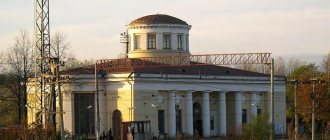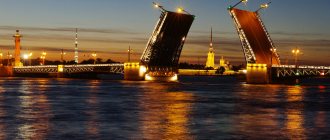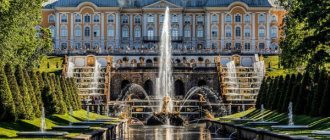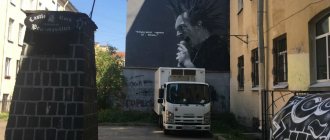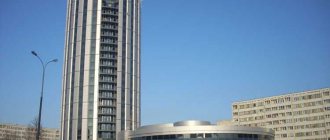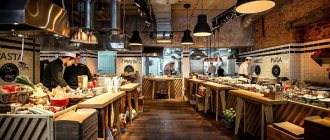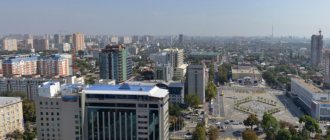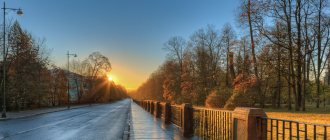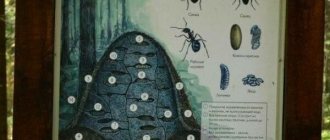| Kind of work: | Essay |
| Date added: | 21.01.2020 |
- This type of work is not a scientific work, it is not a finished final qualifying work!
- This type of work is a finished result of processing, structuring and formatting collected information intended for use as a source of material for independent preparation of educational work.
If you have a hard time understanding this topic, write to me on WhatsApp, we’ll look into your topic, agree on a deadline, and I’ll help you!
If you want to learn how to correctly carry out and write abstracts on any subject, then on the page “what is an abstract and how to do it” I wrote in detail.
Introduction
St. Petersburg is the largest cultural center in the world and Russia. The city was founded on May 27, 1703 by Tsar Peter I. With the aim of modernizing the Russian economy and establishing close economic, technical and cultural cooperation with the more developed countries of Europe.
St. Petersburg is the second largest city in the country after Moscow. It covers an area of about 600 square kilometers, excluding the suburbs, including about 1,500 kilometers, and is located east of the Gulf of Finland on the Baltic Sea.
Because the city is divided by crisscrossing river, sea and land routes, it is considered Russia's closest strategic hub in Europe. The population of St. Petersburg is about 5 million people.
The history of the city is rich in events. Already in 1712, St. Petersburg became the capital of the Russian crown and turned into a scientific, cultural, industrial and transport center.
During its long existence, the city experienced three revolutions (1905-1907, the February bourgeois-democratic revolution of 1917, the great October socialist revolution of 1917). Which played a huge role in the history of mankind. The most difficult years were the Civil War (1917-1922) and, above all, the Great Patriotic War (1941-1945). St. Petersburg suffered terrible trials: devastation, famine, about three years of blockade.
Despite all the difficulties, today more than 85% of the monuments of the 18th-19th centuries have been preserved. This unique cultural and historical heritage has survived to this day and is carefully protected by local authorities.
St. Petersburg is one of the few cities in Russia that has preserved numerous monuments of material and spiritual culture, reflecting all stages of the city’s history. In the city on the Neva you can see not only individual buildings and structures, but also entire streets and squares, since they were practically unchanged in the 17th, 19th and 20th centuries. Among the main attractions of St. Petersburg:
- Saint Isaac's Cathedral;
- Castle Square;
- Aurora Cruiser;
- Nevsky Avenue;
- Peter-Pavel's Fortress;
- Church of the Resurrection of Christ;
- Art camera;
- Peterhof.
Vasilyevsky Island
From here the construction of the city began. Here, on a small island at the mouth of the Neva, many attractions await you: the Menshikov Palace, the Troekurov House (a typical example of an 18th-century building), St. Andrew's Cathedral and Egyptian sphinxes made of pink granite on the embankment. To see all these sights of St. Petersburg, it is best to rent a hotel on Vasilievsky Island https://viahotel.ru/hotels/district/vasilievskiy-ostrov. You can get to the island through the Blagoveshchensky or Palace Bridge, from where incredible views of the city open up at night.
Saint Isaac's Cathedral
Being next to the cathedral, you are always amazed by its grandeur and grandiose size. Nothing looks like either the Savior on the Blood puppet or the Kazan Cathedral (which is by no means an exact copy of St. Peter's in Rome), inspired by the spirit of Ancient Rome.
The history of the construction of St. Isaac's Cathedral dates back to the earliest years of the existence of St. Petersburg. According to the church calendar, the day of St. Isaac of Dalmatia is May 30, the birthday of Peter I. In honor of his patron, Peter I ordered the construction of a wooden church. Appeared in 1710 on the western flank of the Admiralty.
In 1717, to the west of the Admiralty, construction began on the stone St. Isaac's Church according to the design of G.I. Matarnova. Construction was delayed until the 1750s, and as the ground beneath the foundation suddenly began to settle, the church had to be dismantled.
Then came the time of Catherine II, who tried to decorate St. Petersburg with buildings corresponding to the significance of the capital of a powerful empire.
In 1768, construction began on St. Isaac's Cathedral, designed by Antonio Rinaldi, on the site where the current building stands. By 1796 - the year of Catherine II's death - the cathedral was only half built. Paul I decided to donate all the marble intended for the construction of the cathedral to the Mikhailovsky Palace, and the cathedral was completed in brick.
In 1809, Alexander I announced a competition for the construction of a new St. Isaac's Cathedral, which was won by the French architect Auguste Montferrand. The masonry was dismantled, and in 1818 the ceremonial laying of the foundation of the new cathedral took place. Construction lasted 40 years until 1858, and there were rumors among St. Petersburg residents that a certain seer predicted Montferrand's death after construction was soon completed. They said that this is why it took him so long to build. Montferrand died a month after the completion of the cathedral.
The scaffolding was not removed for some time. The cathedral was built, according to them, in bad faith and required constant repairs and reconstruction. The money for it came from the royal treasury, so rumors spread in the city that he would destroy the Romanovs, and the royal house would fall when the forests were removed. They were filmed in 1916, on the eve of the fall of the autocracy in Russia.
During construction and after it, the cathedral evoked conflicting feelings among St. Petersburg residents: from boundless admiration to complete rejection. Opponents talked about disproportions with the surrounding buildings, about the lack of good taste of the architect, about a disproportionately high barrel with ridiculous bell towers.
In any case, today St. Isaac's Cathedral is a symbol of the city, along with the Bronze Horseman, the Admiralty and the Arrow of Vasilyevsky Island. This museum-monument is one of the most popular among tourists, who have the opportunity to climb to the top of the drum colonnade and admire the panorama of the city center from a height of 43 meters.
Church of the Savior on Spilled Blood
In St. Petersburg, the Church of the Savior on Spilled Blood is an analogue of Moscow's St. Basil's Cathedral. Built in 1881 on the spot where Tsar Alexander II was mortally wounded. The style of construction is Russian Renaissance, in the style of ancient Russian churches with platbands and kokoshniks, mosaic frescoes and many carved sculptures. The huge, bright and colorful domes of the cathedral are visible from almost anywhere in St. Petersburg.
Inside the church is the largest collection of mosaic panels in Europe (over 7,000 square meters in area). The place of the martyrdom of the king is especially noted - it is inlaid with Siberian topazes and gems. In the Mikhailovsky Garden adjacent to the cathedral you can relax under the canopy of the alleys.
State Hermitage Museum
Located in five magnificent buildings on the banks of the Neva in the very center of St. Petersburg: the Winter Palace, the Small, Large and New Hermitages, the Hermitage Theater. Part of the museum is located in the Menshikov Palace and the former General Staff building on Palace Square.
The Winter Palace, designed by the architect B. Rastrelli in 1754-1762, occupies a leading place in this magnificent architectural ensemble and becomes the official residence of the Russian monarchs. Bartolomeo Rastrelli said about his work that it was created “... only for the glory of Russia.” Embodying the spirit of the glorious 18th century, the architecture of the Winter Palace combined the power and energy of the Baroque style with the solemn grandeur of classical interiors.
Almost immediately after the completion of the construction of the Winter Palace, which began under Elizabeth Petrovna, Catherine II became the owner of the palace. It was she who created the Hermitage collection, purchasing the first collection of paintings from the Prussian merchant Gantsovsky in 1764. Collecting works of the greatest masters of art became one of the most important affairs in the life of the empress.
Such outstanding personalities as Diderot, Voltaire and other connoisseurs of world art helped her in creating the collection. A very narrow circle of people close to Catherine had access to the masterpieces she acquired. The Empress named her palace "Hermitage" in reference to the French word for "hermitage".
Over two and a half centuries, the Hermitage has accumulated one of the world's largest collections of works of art - about three million monuments representing the cultural heritage of various peoples from the Stone Age to the present day.
The halls on the first floor of the New Hermitage are dedicated to the exhibition of collections of ancient art. One of the richest sections of the museum is dedicated to the art of Italy. The halls of the Great Hermitage display works from the Renaissance. The pearls of this collection are the “Madonna Litta” and “Madonna Benois”, painted by Leonardo da Vinci. Also on display are works by Raphael, Titian, Joey and Michelangelo.
In the halls of Spanish painting you can see paintings by Velazquez, El Greco, Murillo. Dutch and Flemish art is represented by paintings by Rembrandt, Rubens, Van Dyck, Snyder and Hals. An excellent collection of works by French artists, including works by L. Lenin, N. Poussin, J. Chardin, E. Delacroix. The Hermitage's collection of impressionist and post-impressionist paintings is of great importance. This exhibition presents works by such outstanding masters as O. This exhibition presents works by such famous artists as O. Renoir, P. Picasso and V. Van Gogh.
An important place in the State Hermitage is occupied by the collection of the Department of Prehistoric Culture. Some of the exhibits from this collection are in the “Golden Treasure” of the Hermitage, where remarkable objects of Scythian jewelers found during excavations of burial mounds in the Black Sea region are concentrated.
Some premises of the Winter Palace are occupied by the Department of the History of Russian Culture, which, in addition to paintings, drawings and engravings, displays collections of coins, furniture, costumes and other works of Russian applied art, which later became academic museums.
The Hermitage is famous not only among Russian residents, but also among foreign guests. And, probably, this is the duty of each of our compatriots, if he has not yet visited this wonderful museum, he should definitely visit it!!!!
Unusual places for shopping
"Phonotheque"
Address: Marata, 2
In the shop. Photo: @brikek
If you are an ardent record lover or want to give a gift to your friend who owns a record player, then “Fonoteka” is at your service. This place can hardly be called a store - it is a huge vinyl warehouse where you can find good releases, and also have an interesting time studying the covers of old and new records.
You can also choose the music you like, order coffee and enjoy listening in a cozy environment. Here you can also buy CDs, art-house films, books about music, record players, as well as tickets to concerts.
"Subscription publications"
Address: Liteiny Prospekt, 57
On the second floor of the store. Photo: @great_edward
One of the oldest bookstores in the city is suitable not only for buying books for every taste. Everything is great here - the opportunity to order coffee and enjoy it while reading a magazine from the nearest shelf, comfortable places to read, a homely atmosphere and helpful staff. If you want to feel the cozy atmosphere of St. Petersburg, then be sure to check out “Subscription Editions.”
"Golitsyn-Loft"
Address: Fontanka River Embankment, 20
In the loft area. Photo: @stiganorra
Golitsyn is a fairly large creative quarter. You can devote a separate day to exploring the city's creative clusters. But if you don’t have time for that, then Golitsyn is an excellent choice. It consists of five buildings, which, in addition to cozy cafes, restaurants, bars and creative spaces, are full of unusual shops. Stop buying magnets as gifts for your loved ones - find a truly worthwhile and interesting gift.
Store without packaging B12 ZERO WASTE
Address: 7th line of Vasilyevsky Island, 40B
One of the store counters. Photo: @lookbio
If you or your friends and family are interested in the environment, refuse packages, and encourage you to do the same, then it’s time to do it. In this store you will not find packaged goods - cereals, pasta and spices are sold by weight and placed in your container. What to buy here? Start with string bags or pouches or stylish bamboo toothbrushes. Your eco-activist friend will be delighted!
Hay Market
Address: Moskovsky prospect, 4
Prices at the Senny market. Photo: @yuri_k33
If you are looking for colorful places, then you must visit the Sennaya Market. This is that rare place that takes you back to childhood - sellers screaming from all sides, the smell of fresh fruits and vegetables mixed with the aromas of spicy spices. Not only grandmothers, but also young people come here. At the same time, you can buy seasonal vegetables and fruits here for dinner and breakfast - just keep your eyes open - check what they are selling you and don’t hesitate to bargain!
Palace Square
Palace Square is the main square of St. Petersburg. Parades, holiday concerts, rallies, festivals and other city events take place here. Palace Square is considered one of the most beautiful architectural ensembles not only in St. Petersburg, but throughout the world. The square offers a magnificent view of the Admiralty, Alexander Garden and the beginning of Nevsky Prospekt.
The square was named Palace Square in honor of the Winter Palace, the residence of the imperial family, built in 1754-1762. designed by the architect Bartolomeo Rastrelli in the Baroque style. The architectural ensemble and composition of the square were created later - in the 20-30s of the 19th century, when the General Staff building was built according to the design of the architect Rossi. It is decorated with a triumphal arch topped by a chariot on which stands the winged goddess of victory. The sculptural composition glorifying Russia's victory over Napoleon was made according to sketches by masters Pimenov and Demut-Malinovsky.
In honor of the victory over Napoleon in the War of 1812, in the center of Palace Square stood the Alexander Column, or, as it is also called, the “Alexander Column”, created by the architect Montferrand in 1834. The column reaches a height of 47 m - this is the tallest monument of its kind in world. It is crowned by the figure of an angel, into whose face the sculptor put the features of Alexander I, the emperor who ruled in Russia during the war with Napoleon.
The angel on top of the column symbolizes the peace and tranquility that Russia brought to Europe when it defeated Napoleon. The bas-reliefs on the base of the Alexander Column allegorically personify the glory of Russian weapons and symbolize the courage of the Russian army.
The column weighs 600 tons. It is not dug into the ground and is not fixed to the foundation, but relies solely on accurate calculations and its own weight. The column was erected using specially designed scaffolding and ropes: The construction took only 1 hour and 45 minutes. The column, reminiscent of the triumphal buildings of antiquity, is distinguished by precision of proportions, laconicism of form, beauty of lines and silhouette.
Palace Square, the central square of St. Petersburg, has witnessed many important events that influenced the history of Russia. Palace Square was the site of the tragedy that became known as Bloody Sunday. On January 9, 1905, a group of peaceful demonstrators went to the Winter Palace to petition the Tsar for improved living and working conditions. The demonstrators, mostly workers, were unarmed: they carried icons and portraits of the Tsar in their hands, and on the occasion of Sunday they were dressed in their best clothes.
The demonstrators hoped to address the king with their main demands, but the king was not in the palace, and fire was opened on the unarmed. About 1,000 people were killed and 5,000 seriously injured. The bloodshed that gave Bloody Sunday its name was the impetus for the first revolution in Russia.
The revolutionary situation in the country and a number of other circumstances led to Tsar Nicholas II abdicating the throne in February 1917. Power passed to the Provisional Government, and from the summer of 1917 the Winter Palace became its official residence. During the revolutionary events of 1917, the Winter Palace became the main target of the Bolshevik partisans. On October 25 (November 7, new style), 1917, representatives of the Bolshevik Party walked through the Arc de Triomphe, crossed Palace Square and entered the Winter Palace. In one of the rooms of the palace, the Provisional Government was arrested, power passed to the Bolshevik Party and a new era began in the history of Russia.
Summer garden
During the warm season, be sure to make time to visit the Summer Garden. This is one of the oldest parks in the city, which began its work in 1709. It’s as if you’ll be transported back several centuries, walking in the shade of the alleys or looking at the numerous marble sculptures.
The park is as close as possible to the place of recreation that delighted the city residents (the park became a public place in the 19th century). Here even the lattice is considered a masterpiece of classicism and one of the most beautiful fences in the world. The canopy of trees and fancy fountains will give you coolness. It is noteworthy that the name of the Fontanka River comes from the numerous water sources of the Summer Garden. And beautifully decorated pavilions in the style of late classicism with exhibition halls inside will provide shelter from the rain.
Cruiser Aurora
The cruiser "Aurora" remains to this day a monument and symbol of the October Socialist Revolution. The cruiser "Aurora", which fired its only shot on October 25 (November 7), 1917, forever went down in history as the embodiment of the revolution, and to this day stands on the Neva, on the Petrograd embankment, opposite the Winter Palace as a museum - a living legend. The history of the cruiser Aurora dates back to 1897: on May 23, its construction began at the NovoAdmiralty Shipyard.
Three years later, on May 11, 1900, the cruiser was launched, and three years later, in July 1903, she joined the ranks of warships of the Russian fleet. The cruiser "Aurora" took part in the Russian-Japanese War: as part of the Second Pacific Squadron, the ship approached the shores of the Far East and took part in the Battle of Tsushima on May 14-15, 1905. After the end of the Russo-Japanese War, the cruiser Aurora returned to the Baltic Sea and for a long time served as a training ship on which midshipmen of the Marine Corps trained.
Between 1906 and 1912, the cruiser traveled around the world, and in 1911, the Aurora's crew was even allowed to take part in the celebration of the coronation of the King of Thailand in Bangkok. With the outbreak of the First World War, the cruiser Aurora was again deployed to the Baltic Sea: it was supposed to take part in the Second Cruiser Brigade. At the end of 1916, the cruiser, in need of repairs, was delivered to the Petrograd shipyard.
In 1917, Russia was swept by a wave of revolutionary actions. The crew of the cruiser "Aurora" did not stand aside from the revolutionary events of February and October and took part in the subsequent civil war. As you know, the Bolsheviks are on the side of the Reds. The historic salvo from the Aurora's bow cannon, signaling the attack on the Winter Palace, was fired on October 25, 1917 at 21:45.
In 1922-1923 The cruiser again became a training ship for students of the Leningrad naval schools and set sail again, visiting the ports of many countries.
A new war - and new actions at the expense of the glorious cruiser. During the Great Patriotic War, the Aurora defended Leningrad as part of the Chudskaya military flotilla. The ship was fired at several times, received a lot of water and landed on the bottom. In 1944, the Aurora was raised from below, sent for repairs, and on November 17, 1948, the cruiser was placed on an “eternal stay.” In 1965, a Maritime Museum was opened on board the Aurora. In 1992, the St. Andrew flag was raised on the cruiser again. The Aurora belongs to Nakhimov College, and its students are on duty on board the famous cruiser.
Nevsky Avenue
Nevsky Prospekt is the main street of St. Petersburg, which is always glorified in literature and art. Nevsky Prospekt is 4260 meters long and begins at the Admiralty and ends at the Alexander Nevsky Lavra. The history of the boulevard dates back to the first years of St. Petersburg.
When the Admiralty Shipyard was opened, all materials for the construction of ships were delivered along this street, which ended in front of the Admiralty. To facilitate traffic to the Admiralty, Bolshaya Prospekt Street was built, which in 1738 was named Nevsky Prospekt, and in 1783 renamed Nevsky Prospekt. Later, Nevsky Prospekt became not only the first area of regular development, but also the center of the social and cultural life of the city.
From the Admiralty to the Moika, the original width of Nevsky Prospekt has been preserved. The building of the former Merchant Bank, on 7/9, where Aeroflot is now located, is an interesting example of eclectic architecture of the early 20th century, reproducing the image of the Venetian Doge's Palace (architect M. Peretyatkovich). Houses No. 15 and No. 18 are associated with the name of A.S. Pushkin: In the first there was the Talon restaurant, mentioned in Eugene Onegin, and in the second there was the Wolf and Beranger confectionery, which the poet visited shortly before his duel.
After crossing the Moika you will see the building of the Dutch church (architect P. Jacot) and the Stroganov Palace, a beautiful example of Russian Baroque, built by Rastrelli. Next is the complex of the Peter and Paul Lutheran Church (architect Bryullov), and in the area between Kazanskaya Street and the Griboyedov Canal there is the famous Kazan Cathedral, built in 1801-1811 by Anton Voronikhin. The Kazan Cathedral was built in 1801-1811 by A. Voronichin. Kazan Cathedral is the burial place of Field Marshal Kutuzov. The majestic semicircle of the cathedral colonnade overlooks Nevsky Prospekt. Opposite is a view of the Church of the Savior on Spilled Blood (architect Parland).
Further along the avenue there is house number 30, the so-called “Engelhardt House”. Famous composers of the 19th century performed in the Engelhardt Concert Hall, and today it houses the Small Hall of the St. Petersburg Philharmonic. Then you will see the Catherine Church (designed by A. Rinaldi), the Armenian Church, the City Duma building topped with a tower, Gostiny Dvor (designed by J.B. Wallen-Delamotte), and opposite the Passage department store. Behind Sadovaya Street there is the ensemble of Ostrovskaya Square with the Public Library, the famous monument to Catherine II, and in the rear of the building of the Alexandrinsky Theater, designed by C. Rossi.
Behind the Anichkov Bridge across the Fontanka, decorated with the famous horses of Klodt, on Nevsky Boulevard there is the Beloselsky-Belozersky Palace (architect A. Stackenschneider). The central building on Vosstaniya Square is the Moscow Railway Station (architect K. Ton), which closely follows the architectural concept of the Leningradsky Station in Moscow.
Behind Vosstaniya Square, Nevsky Prospect changes direction at an angle; its historical name is Staro-Nevsky Prospekt. Nevsky Prospect ends at Alexander Nevsky Square, where the Alexander Nevsky Lavra complex, founded during the reign of Peter the Great, begins. Here you can visit the Trinity Cathedral and the Church of the Annunciation, which houses the exhibition of the Museum of Urban Sculpture, under the auspices of which the famous necropolis is located.
Nevsky Prospekt is the face of St. Petersburg, the historical main thoroughfare of the city.
Admiralty
During a tour of the city, it is difficult to ignore this building - the maritime museum, which was there from 1823 to 1940. Three main streets of the city converge at it, and the spire of the building (72 meters high), decorated with a weather vane - a boat, has long become a symbol of St. Petersburg. And the Admiralty itself is an outstanding architectural monument of the 18th century, a wonderful synthesis of sculpture and architecture. There are 56 sculptures, 11 reliefs, 50 stucco decorations, united by the common theme “The Glory of the Russian Fleet”.
Peter-Pavel's Fortress
On May 27 (May 16, old style), 1703, the St. Petersburg Fortress, which later became known as the Peter and Paul Fortress, was founded on Zayachy Island, located at the mouth of the Neva, not far from its tributary in the Gulf of Finland on two arms. Earthen ramparts 7 meters high and 15 meters wide were built, on which 300 cannons were installed. Log barracks were built inside the ramparts.
Military engineer V.A. Kirshtenstein was entrusted with the construction of the fortress until 1705. By 1706, the Peter and Paul Fortress was an irregular polygon extending from west to east, with six bastions, pentagonal in shape, protruding from the corners and connected by straight walls, curtains, on the defensive fronts.
By 1706, the Peter and Paul Fortress was an irregular polygon stretching from west to east, with six pentagonal bastions protruding from the corners and connected to the defensive fronts by straight walls - curtains.
To strengthen the main rampart of the fortress, his plan was adapted in 1708-1709; on the northern shore of the narrow strait separating Sayachy Island from Berezovaya, a crownwork was built - another additional structure in the form of a bastion and two half-bastions.
Peter I played a significant role in the design of the Peter and Paul Fortress. The contours of the fortress were determined by the natural contours of the shores of Hare Island. It had the shape of an elongated hexagon with six protruding bastions, which made it possible to conduct massive frontal and flanking artillery fire on the approaches to the fortress.
Construction was carried out by the team of Peter I - A.D. Menshikov, G.I. Golovkin, N.M. Zotov, Yu.Ya. Trubetskoy, under the leadership of K.A. Naryshkina. The fortress bastions were named after them. One of the bastions was named after the ruler Peter I.
The construction of the fortress was carried out during the war with the Swedes. On July 24, 1704, the Swedish general Maidel reported to Stockholm: “St. Petersburg is very well built and fortified, its position is such that it can become both a strong fortress and a prosperous trading city.” If the king holds out for several years, his power at sea will become significant."
When a Swedish detachment of 8,000 men and a squadron of 12 ships approached St. Petersburg and Kronstadt in 1704, Russian troops drove the enemy back without much loss. The following year the Swedes again tried to capture the city and fortress.
The reconstruction of the Peter and Paul Fortress in stone began on May 30, 1706 and continued intermittently until 1740. The demolition of the adobe fortress and the construction of a new pile foundation (about 40,000 piles were driven under the stone walls of the fortress) from brick and stone were carried out gradually in small areas so that the fortress did not lose its defense capability. The southern bastions were moved further to the Neva.
The architect Domenico Trezzini was responsible for the construction of the stone fortress. The Italian native was born in Switzerland and worked as an architect at the court of the Danish king. In 1703, Trezzini accepted the offer of the Russian diplomat Izmailov, who worked for Peter I in Russia and invited fortress builders and architects, and came to St. Petersburg.
Trezzini was the first architect of the young capital. Since 1706, he began working on “the most important of the greatest works” - the stone reconstruction of the Peter and Paul Fortress and the construction of various buildings on its territory, to which he devoted almost 30 years of his life.
Now the Peter and Paul Fortress is one of the most popular places among tourists. After all, this is where the history of one of the most unusual cities in our vast country began!
Eat, drink, have a snack
Cafe "Brother"
Address: Bolshaya Morskaya, 10
Inside the cafe. Photo: @cafe_brat
Do you like a calm atmosphere and delicious coffee? The small cafe "Brother", which is located near Palace Square, has all this in abundance. They serve delicious breakfasts, pasta and desserts for lunch, and a variety of coffee and healthy cocktails made from arugula and spinach.
If you want to take a comfortable place and enjoy aromatic coffee, we recommend booking your seat in advance.
Clock face
Address: Stachek, 72
Lecture in Dial. Photo: @tvoyziferblat
If you are away from the center, but also want to feel the cozy atmosphere of St. Petersburg, then we invite you to visit the free space “Tsiferblat”. Here they pay not for coffee, but for time. You can come here to work or attend one of the events, meet interesting people and get access to unlimited tea and coffee with cookies.
More coffee
Address: Alexandrovsky Park, 3G
On the summer veranda of a coffee shop. Photo: @olia__is
There is another interesting place in the Alexander Garden - a coffee shop in an ancient grotto. During the cold season, you can sit inside the grotto and immerse yourself in the atmosphere of childhood, looking at all sorts of old posters and other interesting design elements. And in the summer we invite you to take your coffee with you and sit on the cozy summer veranda near the grotto.
Well, if you want to get to know the local gastronomic diversity better, then go on a real gastronomic tour of the city.
As you can see, besides walking along Nevsky, there is something to do in St. Petersburg. We hope that you will find a place that you will happily tell all your friends and family about.
Rubinshteina Street and the Bar Triangle
Where do St. Petersburg residents spend Saturday evenings? Of course, on Rubinstein or in one of the bars of the Bar Triangle. The best drinking establishments in the city have accumulated here: the Bachelor bar, Blue Pushkin, Chronicles, Zaliv, Barslona... You can get confused by their number. If you're afraid of missing out on something, go on a bar tour in St. Petersburg or a gastro tour along Rubinshteina Street. Yes, St. Petersburg guides offer these too!
Bar Chronicles. Photo: @xronikibar
Church of the Resurrection
The Church of the Resurrection of Christ was built on the site where, on March 1, 1881, one of the members of the terrorist society “Narodnaya Volya” (I.N. Grinevitsky) fatally shot Tsar Alexander II. Hence the other names of the temple - “Savior on Blood”, “Church on Blood” - metaphors, as if showing a parallel between the martyrdom of Christ and the death of Alexander II.
The cathedral was built according to the design of the architect A.A. Parland and the rector of the Trinity-Sergius Hermitage, Archimandrite Ignatius (secular name I.V. Malyshev), a former student of the Academy of Arts. The authors proposed to take the architecture of Moscow and Yaroslavl as a basis, using the composition of St. Basil's Cathedral on Red Square in Moscow. The temple was built from 1883 to 1907. The cathedral building was erected directly on the bank of the Catherine Canal (now the Griboyedov Canal), so that the site of the Tsar’s wound was enclosed within its walls. To do this, it was necessary to build a special strong foundation, which was shifted 8 meters into the bottom of the canal.
The nine-domed temple for 1,600 people was consecrated on October 6, 1883 in the presence of the highest authorities, even before the final approval of the project, since the first three years had to be spent on strengthening the soil and building the foundation. The columns, cornices, draperies and architects were made of Estonian marble. The most important events and decrees of the reign of Alexander II were carved on 20 dark red tablets attached to the base.
In 1894, the construction of the vaults and pendants was completed. The following year, the domes were built at the capital's metallurgical plant, five of which were covered with special enamel of various colors at Andrei Postnikov's factory. On 6.VII.1897 a cross was erected on the main tent, 81 m high.
Outside, under the bell tower, on the site of his mortal wound, stands the “Crucifixion with Those Walking” with a cross made of marble and granite, in front of which an ever-burning lamp has burned out. On the sides there are icons of saints celebrated on the birthday and death of the murdered emperor, and icons that, according to the drawings of Akad. P. Cherkasov on the copper coats of arms of the provinces and regions of Russia. Under the gilded dome of the bell tower there is a mosaic part of the prayer of St. Basil the Great, which embodies the penitential idea of the temple.
Mosaics almost completely cover the interior of the temple, making it the only example of this art in the world in the new era. Mosaic work delayed the dedication of the temple for almost ten years, which was completed on August 19, 1907 by Metropolitan Anthony in the presence of the emperor. For this occasion, a special medal was minted at the mint. The cost of the entire construction amounted to 4.6 million rubles.
The drawings for the interior mosaic were made by V.V. Belyaev, N.N. Kharlamov, A. Ryabushkin, N. Koshelev, N. Shakhovskoy, A. Novoskoltsev and others. In the main nave, according to the canon, the earthly life of the Savior is depicted, in the western part - the Passion, Crucifixion and Resurrection, in the east - the scene after the Resurrection. All mosaics are made at the highest level and amaze with their artistic unity.
The workshop of G. Novi in Genoa produced a low iconostasis from polychrome marble according to Parland's design, topped with three crosses made of rock crystal. The four icons were painted by Nesterov and local artists Viktor Vasnetsov. The mosaic icons in the royal gates were made of silver at the Khlebnikov factory of the Frolov workshop according to sketches by N. Bruni.
The richest tableware was supplied by the companies of Khlebnikov and Frolov, who worked on projects by S.F. Komarova. The two-story silver case with enamel inserts for the altar Gospel was made in the workshop of the famous jeweler P. Ovchinnikov. A silver tabernacle was brought from Kostroma, another made of jasper and eagle - from a lapidary factory in Yekaterinburg.
After the altar, the main space of the temple was occupied by a magnificent canopy, supported by columns of gray-violet jasper, crowned with a topaz cross and surrounded by an openwork wrought iron lattice. He stood over the preserved fragment of the cobblestone where the murder of the prince took place. Colorful, unfading lamps suspended in the halls create a special mood of sadness and confidence. On the day of the murder, a memorial service and daily liturgy were held here.
In 1923, the church received the status of the cathedral of the diocese, and four years later it became a stronghold of the “Josephites.” By decision of the Presidium of the All-Russian Central Executive Committee on November 17, 1930, the church was closed and transferred “for cultural and educational needs.” In 1934, the Society of Political Typists held the exhibition “People's Will” in the cathedral. However, a year later it was closed, the church was removed from state protection, calls were made for the demolition of this masterpiece of Russian architecture, and a plan to this effect was drawn up even before the war.
It was only in 1956 that the building regained its status as a monument, although abuses continued: workshops, a potato warehouse and a decoration store. Again the idea arose to demolish the cathedral. In 1970, St. Isaac's Cathedral was transferred as a branch to the St. Isaac's Cathedral Museum and complex restoration work was carried out, which is now close to completion. The community, registered in 1990, asked believers to return the cathedral, but the museum management did not do this.
Anyone who has visited the cathedral knows how captivating its image is! It is impossible to pass by without spending at least a few minutes under the arches of the Church of the Resurrection!
Kunstkamera
The name “Kunstkamera” comes from the German Kunst - art, art and Kammer - Raritätenkabinett. The Kunstkamera is the first state museum complex in Russia, one of the most important institutions of the St. Petersburg Academy of Sciences. Founded by Peter I on the model of similar museums in Europe, the Kunstkamera was conceived by its founder as a pillar of European science in Russian society.
The Kunstkamera was founded in 1714, when the personal collection of rarities of Peter I and the collections of the Apothecary Department were transferred from Moscow to St. Petersburg and placed in the Summer Palace. They were assigned a special staff: “chief boss” R.K. Areksin, a medical worker, and “librarian and curator of rarities and naturalities” I.D. Schumacher. In 1719, the collection and library of the Tsar’s Art Chamber were moved to the confiscated house of A.V. Kikin, “Kikin Chambers” near the Smolny Dvor. From that time on, the Kunstkamera was open to the public: by order of Peter I, it was to be open to all visitors so that “people could watch and learn.”
The collections brought by Peter I from his first trip to Europe in 1697-1698 became the basis of the Kunstkamera collection. After this, the exhibits were collected by several government decrees. The domestic market played an important role in replenishing the museum, especially the first academic expeditions, purchases abroad and private donations. The principle of universality, which is the basis of collecting, allowed the Kunstkamera to present the world in all its diversity in a limited space.
Peter I very successfully chose the place for the construction of a special building for the Kunstkamera. Located on the banks of the Neva, the building is clearly visible from a great distance. M.V. Lomonosov explained this location of the Chamber of Arts by the fact that Peter I wanted “everyone to look at it, think about the sciences and love them.” The building was built according to the design of A. Schlutter (probably) and G. Matarnovi by architects N. Gerbel, G. Chiaveri, M. G. Zemtsov.
The building of the St. Petersburg Art Chamber was built under the influence of German Baroque. It was three-sided, consisted of two identical buildings, decorated with pediments, and was connected to a multi-story tower. Inside, the space was organized according to the ideal model of a museum exhibition of that time. By the early 1740s. the Kunstkamera housed a significant number of exhibits.
In 1747, at the height of its heyday, there was a fire that caused irreparable damage to the museum. In the period from 1751 to 1757, under the leadership of S.I. Chevakinsky, the building was restored in a partially reconstructed form.
To restore the collection, in 1765 the Academy of Sciences turned to the government with a request to collect materials for the museum. In connection with the general direction of differentiation of sciences, in 1803 the Botanical, Zoological, Asian, Egyptian, Mineralogical and Ethnographic departments were created.
Today the Kunstkamera houses the Peter the Great Museum of Anthropology and Ethnography, which was created on the basis of the collections of Peter the Great and significantly expanded in subsequent years. Soon after the Second World War, the M.V. Museum was opened in the halls of the Kunstkamera. Lomonosov. The great Russian scientist worked in this building for almost a quarter of a century. The museum's collection is dedicated to the beginning of the Academy of Sciences and Lomonosov's contribution to the history of Russian science. The museum displays documents and objects from Lomonosov's time, including scientific instruments, books, portraits, engravings, including from the personal collection of the first Russian academician.
Church
In 1923, the church received the status of a cathedral of the diocese, and four years later it became a stronghold of the “Josephites.” By the decision of the Presidium of the All-Russian Central Executive Committee, the church was closed on November 17, 1930 and transferred “for cultural and educational needs.” In 1934, the Society of Political Typists held the exhibition “People's Will” in the cathedral. However, a year later it was closed, the church was removed from state protection, calls were made for the demolition of this masterpiece of Russian architecture, and a plan to this effect was drawn up even before the war.
Today, the art chamber houses the Peter the Great Museum of Anthropology and Ethnography, created on the basis of the collections of Peter the Great, which were significantly expanded in subsequent years. Soon after the Second World War, the M.V. Museum was opened in the halls of the Kunstkamera. Lomonosov. The great Russian scientist worked in this building for almost a quarter of a century. The museum's collection is dedicated to the beginning of the Academy of Sciences and Lomonosov's contribution to the history of Russian science. The museum exhibits documents and objects from Lomonosov's time, including scientific instruments, books, portraits, engravings, including from the personal collection of the first Russian academician.
Peterhof
Thirty kilometers from the swampy swamps of the capital of the Russian Empire, Peter I, during his regular inspections of Kronstadt, admired the resting place, where he personally supervised the construction of fortifications. The location of the cape, from which the capital Kronstadt and the northern coast of the Gulf of Finland are visible, was so favorable that soon after the Tsar's summer residence, carpenters moved here - it was called Peterhof - Peter's Court.
Top architects and decorators such as Braunstein, Leblon, Micheletti, Felten and Delamotte designed the appearance of Peterhof. Engineers under the leadership of hydraulic engineer Vasily Tuvolkov and with the direct participation of Peter I designed a complex technical water supply system for fountains, historically unique and functioning almost without damage for almost three hundred years to this day.
The eternally restored center of the courtyard reached the zenith of its splendor during the reigns of Elizabeth and Catherine the Great, who founded this beautiful natural site on the shores of the Gulf of Finland. The halls of the palace and the main staircase were rebuilt according to the design of Bartolomeo Rastrelli, and the parks were restored in the traditions of French art of the 18th century.
During World War II, Peterhof was completely destroyed, and only since 1960 has it been largely restored using surviving drawings and numerous photographs.
More than 140 fountains decorate the Upper and Lower Peterhof Park, especially the large cascade in front of the palace has a solemn effect. Along with other fountains, the Broad Canal and a landing stage for guests coming from the sea, the recast and gilded sculptures of Samson and the Lion symbolize the invincible power and the new dawn of the Russian state. Do not deny yourself the pleasure of admiring the palace; it is especially beautiful at the hours when the sun shines through its huge windows, and in the evening, when the chandeliers are illuminated: the gilded carvings sparkle, the light plays on the solemn portraits.
